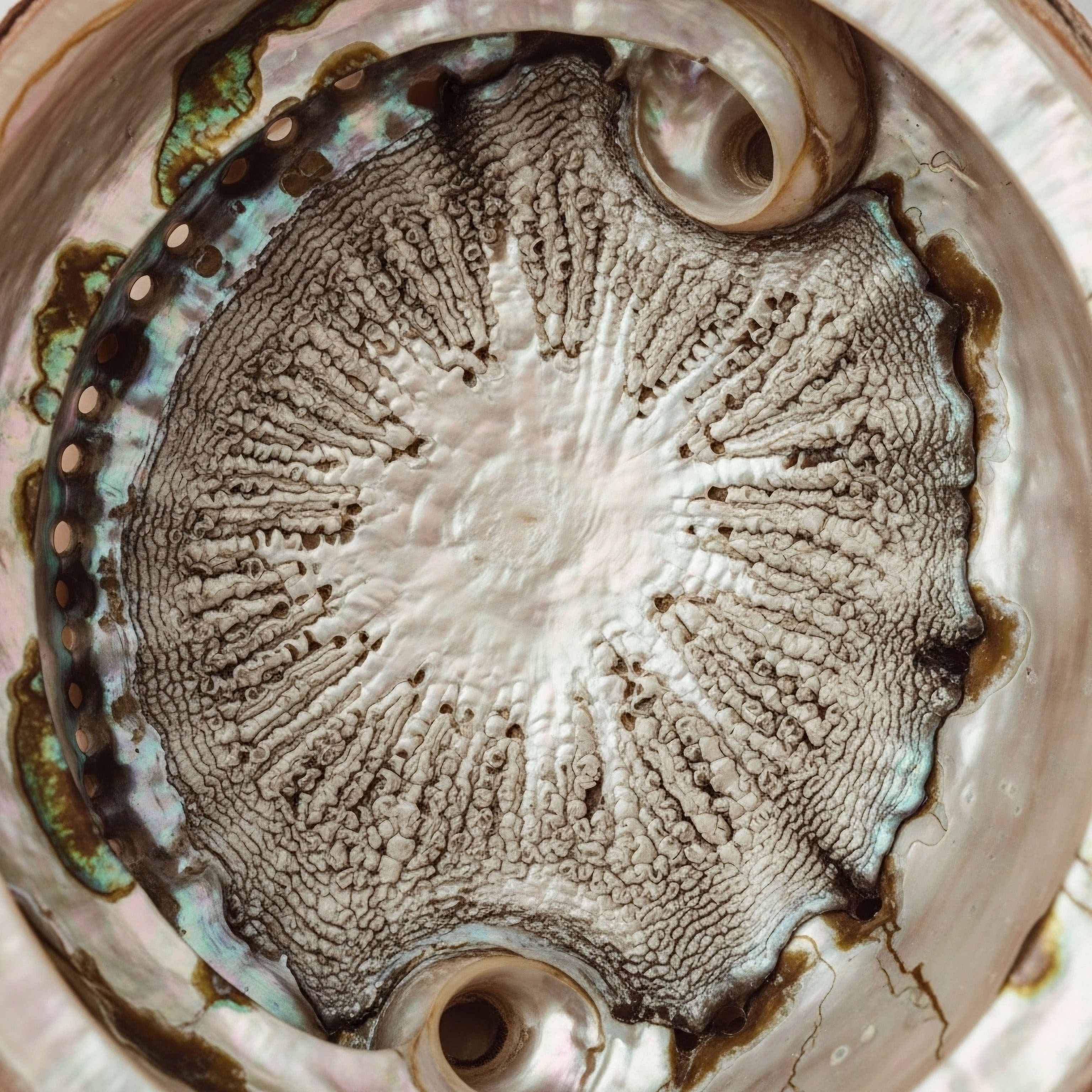

Fundamentals
Have you ever experienced a persistent sense of fatigue, a subtle shift in your mood, or a noticeable change in your body’s responsiveness, despite maintaining your usual routines? Perhaps your sleep feels less restorative, or your drive for activity has waned. These experiences, often dismissed as simply “getting older” or “stress,” frequently signal a deeper conversation happening within your biological systems.
Your body communicates through an intricate network of chemical messengers, and when these signals become muffled or misdirected, the impact can ripple across every aspect of your well-being. Understanding this internal dialogue, particularly how it relates to your hormonal health, represents a profound step toward reclaiming your vitality.
The human body operates as a symphony of interconnected systems, with the endocrine system serving as its primary conductor. This system comprises glands that produce and release hormones, which are potent chemical messengers traveling through your bloodstream to orchestrate a vast array of physiological processes. Hormones regulate everything from your metabolism and growth to your mood and reproductive function.
When we discuss sex hormones, such as testosterone, estrogen, and progesterone, we are referring to a class of compounds that exert widespread influence, extending far beyond reproductive capacity. They affect bone density, muscle mass, cognitive clarity, cardiovascular health, and even your body’s ability to manage stress.
Your dietary patterns Meaning ∞ Dietary patterns represent the comprehensive consumption of food groups, nutrients, and beverages over extended periods, rather than focusing on isolated components. stand as a foundational pillar influencing this delicate hormonal balance. The foods you consume provide the raw materials for hormone synthesis, influence the enzymes that convert one hormone into another, and shape the cellular environments where hormones exert their effects. Ignoring this fundamental connection is akin to expecting a complex machine to operate optimally without the correct fuel or lubrication. Every meal, every snack, contributes to the ongoing biochemical processes that dictate your hormonal landscape.
Your daily food choices provide the essential building blocks and regulatory signals for your body’s complex hormonal communication network.
Consider the foundational role of dietary fats. Steroid hormones, including testosterone, estrogen, and progesterone, are synthesized from cholesterol. This vital molecule, often misunderstood, is not merely something to be avoided; it is a fundamental precursor.
While your liver produces a significant amount of cholesterol, dietary intake of healthy fats provides additional substrate and influences the efficiency of this production. A diet severely restricted in healthy fats can, over time, compromise the availability of these essential building blocks, potentially affecting the production of these critical sex hormones.
Beyond raw materials, dietary components influence the sensitivity of your cells to hormonal signals. For instance, chronic consumption of highly processed foods, rich in refined carbohydrates and unhealthy fats, can lead to insulin resistance. When cells become less responsive to insulin, the pancreas produces more of it, leading to elevated insulin levels.
This state of hyperinsulinemia can directly impact sex hormone-binding globulin (SHBG), a protein that binds to sex hormones Meaning ∞ Sex hormones are steroid compounds primarily synthesized in gonads—testes in males, ovaries in females—with minor production in adrenal glands and peripheral tissues. in the bloodstream, making them inactive. Higher insulin levels often correlate with lower SHBG, leading to more free, active hormones, which might sound beneficial but can disrupt the delicate balance, particularly in women with conditions like Polycystic Ovary Syndrome (PCOS).
The quality of your dietary protein also plays a significant role. Proteins break down into amino acids, which are indispensable for the synthesis of peptide hormones, enzymes involved in hormone metabolism, and neurotransmitters that regulate the entire endocrine axis. For example, adequate protein intake Protein intake provides essential building blocks and metabolic signals that support, but do not directly increase, the body’s own testosterone production. supports the production of growth hormone-releasing peptides and thyroid hormones. A diet lacking in diverse, high-quality protein sources can therefore impede these vital processes, leading to a cascade of systemic imbalances that manifest as subtle yet pervasive symptoms.
Understanding these foundational principles allows us to move beyond simplistic notions of “good” or “bad” foods. Instead, we begin to appreciate how specific dietary patterns create an internal environment that either supports or undermines hormonal equilibrium. This knowledge empowers you to make informed choices, recognizing that your plate holds a powerful influence over your body’s internal messaging system and, consequently, your overall vitality.


Intermediate
Moving beyond the foundational understanding, we can now examine the specific clinical interplay between dietary patterns Sleep deprivation profoundly disrupts endocrine balance, compromising hormonal resilience and metabolic function, impacting overall vitality. and sex hormone production, particularly within the context of targeted wellness protocols. Your body’s endocrine system is not a static entity; it is a dynamic, responsive network constantly adjusting to internal and external cues. Dietary choices represent some of the most potent external cues you can provide, directly influencing the synthesis, metabolism, and action of sex hormones.
Consider the role of macronutrients in modulating hormone levels.

Dietary Fats and Steroid Hormone Synthesis
The synthesis of all steroid hormones, including testosterone, estrogen, and progesterone, begins with cholesterol. Dietary fats provide both cholesterol and the fatty acids necessary for its transport and utilization. A diet rich in healthy fats, such as monounsaturated fats found in avocados and olive oil, and certain saturated fats from quality animal sources, provides the necessary substrate for robust hormone production.
Conversely, very low-fat diets can restrict cholesterol availability, potentially impacting steroid hormone synthesis. The type of fat also matters significantly.
- Saturated Fats ∞ Provide cholesterol precursors and support cell membrane integrity, which is vital for hormone receptor function.
- Monounsaturated Fats ∞ Contribute to cell membrane fluidity and are generally associated with improved insulin sensitivity, indirectly supporting hormonal balance.
- Polyunsaturated Fats ∞ Omega-3 fatty acids, found in fatty fish and flaxseeds, are precursors to anti-inflammatory compounds that can modulate hormonal signaling and reduce systemic inflammation, a known disruptor of endocrine function.
- Trans Fats ∞ These industrially produced fats are detrimental, promoting inflammation and impairing cellular function, thereby negatively impacting hormone production and sensitivity.

Protein Intake and Hormonal Regulation
Adequate protein intake Meaning ∞ Protein intake refers to the quantifiable consumption of dietary protein, an essential macronutrient, crucial for various physiological processes. is indispensable for numerous hormonal processes. Amino acids, the building blocks of protein, are required for the synthesis of peptide hormones, such as growth hormone and insulin. They are also essential for the enzymes that facilitate hormone conversion and detoxification pathways in the liver. For individuals undergoing Testosterone Replacement Therapy (TRT), sufficient protein supports muscle protein synthesis, maximizing the therapeutic benefits of exogenous testosterone.

Carbohydrates, Insulin, and Sex Hormones
The quantity and quality of dietary carbohydrates profoundly influence insulin sensitivity Meaning ∞ Insulin sensitivity refers to the degree to which cells in the body, particularly muscle, fat, and liver cells, respond effectively to insulin’s signal to take up glucose from the bloodstream. and glucose metabolism, which are intimately linked to sex hormone regulation. High intake of refined carbohydrates and sugars can lead to chronic elevations in blood glucose and insulin. This state can increase aromatase activity, the enzyme responsible for converting testosterone into estrogen, potentially leading to undesirable estrogen dominance in men and women.
Conversely, a balanced intake of complex carbohydrates, particularly those rich in fiber, promotes stable blood sugar levels and improved insulin sensitivity. This supports a more balanced hormonal environment, reducing the likelihood of excessive estrogen conversion and supporting healthy testosterone levels.

Micronutrients as Hormonal Cofactors
Beyond macronutrients, specific vitamins and minerals act as essential cofactors in hormone synthesis Meaning ∞ Hormone synthesis refers to precise biochemical processes within specialized cells and glands responsible for creating hormones. and metabolism.
| Micronutrient | Role in Hormone Production/Metabolism | Dietary Sources |
|---|---|---|
| Zinc | Essential for testosterone synthesis and sperm production; influences LH and FSH release. | Oysters, red meat, pumpkin seeds, legumes. |
| Vitamin D | Functions as a steroid hormone; receptors found in reproductive tissues; linked to testosterone levels. | Sunlight exposure, fatty fish, fortified foods. |
| Magnesium | Involved in over 300 enzymatic reactions, including those for hormone synthesis and receptor sensitivity. | Leafy greens, nuts, seeds, whole grains. |
| Selenium | Critical for thyroid hormone production and antioxidant defense, which impacts overall endocrine health. | Brazil nuts, seafood, organ meats. |
| B Vitamins | Cofactors in neurotransmitter synthesis and methylation pathways, vital for hormone detoxification. | Whole grains, meat, eggs, leafy greens. |
Specific micronutrients act as indispensable cofactors, enabling the intricate enzymatic reactions required for hormone synthesis and metabolic regulation.

Dietary Patterns and Clinical Protocols
For individuals undergoing hormonal optimization protocols, dietary patterns become even more significant. For men receiving Testosterone Cypionate, optimizing diet supports the body’s response to therapy. Adequate protein and healthy fats support muscle anabolism and overall cellular health. Managing carbohydrate intake helps control insulin levels, which can influence the balance between testosterone and estrogen, especially when Anastrozole is used to block estrogen conversion.
For women utilizing Testosterone Cypionate or Progesterone, dietary considerations are equally vital. Supporting healthy gut function through fiber-rich foods aids in proper estrogen metabolism and excretion, preventing recirculation of metabolites that can disrupt balance. Adequate nutrient intake ensures the body can effectively utilize and metabolize the administered hormones, maximizing therapeutic benefits and minimizing potential side effects.
The goal is to create a dietary environment that complements and enhances the efficacy of these targeted interventions. This involves not only providing the necessary building blocks but also minimizing inflammatory triggers and supporting metabolic pathways that are essential for hormonal equilibrium.
Academic
The academic exploration of how dietary patterns affect sex hormone production Meaning ∞ Sex hormone production refers to the biochemical processes within specific endocrine glands that synthesize steroid hormones such as androgens, estrogens, and progestogens. requires a deep dive into molecular endocrinology, metabolic signaling, and the intricate feedback loops governing the hypothalamic-pituitary-gonadal (HPG) axis. This systems-biology perspective reveals that diet is not merely a source of nutrients; it is a powerful modulator of gene expression, enzyme activity, and cellular communication, directly influencing the entire hormonal cascade.

Steroidogenesis and Dietary Lipid Metabolism
The biosynthesis of steroid hormones, known as steroidogenesis, begins with cholesterol. Dietary cholesterol and endogenously synthesized cholesterol are transported to steroidogenic tissues, such as the adrenal glands, gonads, and placenta, via lipoproteins. The rate-limiting step in steroidogenesis is the transport of cholesterol into the inner mitochondrial membrane, mediated by the Steroidogenic Acute Regulatory Protein (StAR).
Dietary fatty acid composition can influence membrane fluidity and the efficiency of cholesterol transport and utilization. For instance, diets rich in saturated and monounsaturated fatty acids appear to support cholesterol transport more effectively than diets high in polyunsaturated fatty acids, particularly in the context of testosterone production in Leydig cells.
Enzymes within the cytochrome P450 family, such as CYP11A1 (cholesterol side-chain cleavage enzyme), CYP17A1 (17α-hydroxylase/17,20-lyase), and CYP19A1 (aromatase), are central to the conversion of cholesterol into various steroid hormones. Dietary components can directly influence the activity and expression of these enzymes. For example, certain phytochemicals found in cruciferous vegetables can modulate aromatase activity, affecting the conversion of androgens to estrogens. Similarly, micronutrients like zinc and magnesium act as cofactors for numerous enzymatic reactions within the steroidogenic pathway, underscoring their indispensable role.

Metabolic Signaling and the HPG Axis
The HPG axis, comprising the hypothalamus, pituitary gland, and gonads, is the central regulator of sex hormone production. This axis is highly sensitive to metabolic signals, providing a direct link between dietary status and reproductive function. Key metabolic hormones and adipokines, such as leptin, insulin, and ghrelin, communicate nutritional status to the hypothalamus, influencing the pulsatile release of gonadotropin-releasing hormone (GnRH).
Leptin, secreted by adipose tissue, signals energy sufficiency. Adequate leptin levels are necessary for normal GnRH pulsatility, and thus for the downstream production of luteinizing hormone (LH) and follicle-stimulating hormone (FSH) from the pituitary, which then stimulate gonadal hormone synthesis. Chronic energy deficit, often associated with restrictive dietary patterns, can lead to low leptin levels, suppressing GnRH and subsequently reducing sex hormone production, a phenomenon observed in conditions like functional hypothalamic amenorrhea in women and hypogonadism in men.
Insulin, a key regulator of glucose metabolism, also exerts direct effects on the gonads. Insulin receptors are present on ovarian and testicular cells, and insulin can directly stimulate steroidogenesis. However, chronic hyperinsulinemia, often a consequence of diets high in refined carbohydrates, can lead to insulin resistance and contribute to hormonal imbalances.
In women, this can exacerbate androgen excess in PCOS by increasing ovarian androgen production and reducing SHBG levels. In men, hyperinsulinemia can reduce testosterone production and increase aromatase activity, leading to higher estrogen levels.

The Gut Microbiome and Hormonal Metabolism
A rapidly expanding area of research focuses on the profound influence of the gut microbiome on sex hormone metabolism, particularly estrogen. The collection of gut bacteria possesses enzymes, collectively known as the estrobolome, that deconjugate estrogens in the gut, allowing them to be reabsorbed into circulation. This enterohepatic recirculation of estrogens can significantly impact circulating estrogen levels.
Dietary fiber, a primary substrate for gut bacteria, plays a critical role in shaping the composition and function of the microbiome. A diet rich in diverse fibers promotes a healthy gut microbial community that supports the proper excretion of estrogen metabolites, preventing their reabsorption. Conversely, a low-fiber, high-fat, and high-sugar diet can lead to dysbiosis, potentially altering the estrobolome and contributing to elevated estrogen levels, which can have implications for hormone-sensitive conditions.
| Dietary Pattern | Observed Hormonal Effects | Underlying Mechanisms |
|---|---|---|
| Low-Fat Diets | Reduced total and free testosterone in men; potential impact on estrogen metabolism. | Decreased cholesterol substrate for steroidogenesis; altered membrane fluidity. |
| High-Fiber Diets | Lower circulating estrogen levels; improved insulin sensitivity. | Enhanced estrogen excretion via gut microbiome; reduced enterohepatic recirculation; improved glucose metabolism. |
| Ketogenic Diets | Variable effects on sex hormones; potential for improved insulin sensitivity. | Shifts in metabolic fuel utilization; impact on HPG axis signaling; altered inflammatory markers. |
| Mediterranean Diet | Improved metabolic health markers; potential for balanced sex hormone profiles. | Anti-inflammatory effects; rich in healthy fats and fiber; supports gut health and insulin sensitivity. |
Dietary patterns exert their influence on sex hormone production through complex interactions with metabolic pathways, enzymatic activities, and the gut microbiome.

Can Specific Dietary Interventions Optimize Hormone Protocols?
For individuals undergoing therapeutic interventions such as Growth Hormone Peptide Therapy (e.g. Sermorelin, Ipamorelin / CJC-1295) or Testosterone Replacement Therapy, dietary optimization serves as a powerful adjunctive strategy. For instance, adequate protein intake is essential for maximizing the anabolic effects of growth hormone-releasing peptides. Furthermore, managing insulin sensitivity through carbohydrate modulation can enhance the body’s response to these peptides, as insulin and growth hormone pathways are interconnected.
In the context of male hormone optimization, a diet that supports healthy lipid profiles and reduces systemic inflammation can enhance the efficacy of Testosterone Cypionate while mitigating potential side effects. Similarly, for women on Testosterone Cypionate or Progesterone, dietary strategies that promote healthy estrogen metabolism and gut integrity are indispensable for achieving optimal outcomes and maintaining long-term hormonal balance. The interplay between dietary patterns and the intricate biochemical machinery of hormone production Meaning ∞ Hormone production is the biological process where specialized cells and glands synthesize, store, and release chemical messengers called hormones. is a testament to the body’s remarkable adaptability and the profound influence of personalized nutritional strategies.
References
- Volek, Jeff S. et al. “Dietary fat intake and testosterone levels in men.” Journal of the American College of Nutrition, vol. 28, no. 5, 2009, pp. 525-530.
- Prasad, Ananda S. “Zinc in human health ∞ effect of zinc on immune cells.” Molecular Medicine, vol. 14, no. 5-6, 2008, pp. 353-357.
- Welt, Corrine K. et al. “The effects of leptin on gonadotropin-releasing hormone secretion in normal-weight and obese women.” The Journal of Clinical Endocrinology & Metabolism, vol. 85, no. 7, 2000, pp. 2501-2507.
- Pasquali, Renato, et al. “The impact of insulin resistance on the male reproductive system.” Clinical Endocrinology, vol. 62, no. 2, 2005, pp. 131-141.
- Fuhrman, Barbara J. et al. “Dietary fiber and the estrobolome ∞ A systematic review.” Journal of Steroid Biochemistry and Molecular Biology, vol. 200, 2020, pp. 105658.
- Hyman, Mark. “The Blood Sugar Solution ∞ The UltraHealthy Program for Losing Weight, Preventing Disease, and Feeling Great Now!” Little, Brown and Company, 2012.
- Gottfried, Sara. “The Hormone Cure ∞ Reclaim Your Body’s Natural Balance to Lose Weight, Look Younger, and Feel Great.” Scribner, 2013.
- Attia, Peter. “Outlive ∞ The Science and Art of Longevity.” Harmony, 2023.
Reflection
As we conclude this exploration, consider the profound implications of your dietary choices on your internal biological landscape. The journey toward optimal hormonal health is deeply personal, reflecting the unique interplay of your genetics, lifestyle, and environmental exposures. The knowledge shared here serves as a guide, illuminating the intricate connections between what you consume and how your body functions at its most fundamental level.
This understanding is not merely academic; it is a call to introspection. What patterns in your diet might be supporting your vitality, and where might there be opportunities for recalibration? Recognizing the body’s inherent intelligence and its capacity for balance, given the right inputs, can be a truly transformative realization. Your path to reclaiming robust function and sustained well-being begins with informed choices, guided by a deeper appreciation for your own biological systems.
The insights gained are a starting point, not a destination. True personalized wellness protocols arise from a careful assessment of individual needs, often requiring precise clinical guidance to translate these broad principles into actionable, tailored strategies. May this information serve to empower your ongoing commitment to a life of sustained health and vibrant function.










